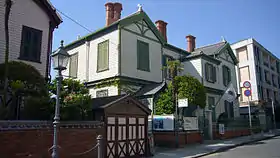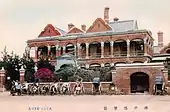Alexander Nelson Hansell
Alexander Nelson Hansell (6 October 1857[1]: 103–104 [note 1] – 1940) was a British architect known primarily for his activities in Kobe, Japan. In 1891 he became a fellow of the Royal Institute of British Architects[2][note 2] He had an apprentice named Yokoyama Eikichi.[4]: 178

Life

Hansell was born on 6 October 1857 in Caen in Normandy, France.[1]: 103–104 His father Peter Hansell was a British[4]: 173 pastor,[1]: 103–104 who had been rector of Kingsdon, Somerset before being appointed as Consular Chaplain of Caen on 11 October 1853.[5] Father and son later returned together to Somerset, England.[4]: 173
At some point Alexander moved from Somerset to Winchester, where he studied architecture,[4]: 173 and in 1888 he moved to Japan. He worked teaching English at a seminary on Lot 18 of the Kawaguchi foreign settlement in Osaka[1]: 105 before beginning his activities as an architect. His first job was the planning of the Harris Science Hall at Doshisha University.[1]: 105 He continued on to design the clubhouse of the newly renamed Kobe Club at the Kobe foreign settlement, and was thereafter involved in the planning of many more structures both inside the foreign settlement and in the surrounding mixed residential zone.[1]: 105–106
During the First World War, Alexander's only son Kenneth was killed in battle.[6] Alexander mourned his loss greatly, and in 1920 he moved to Hankou in China, and then later to Monaco, where he died.[4]: 178–179
Hansell's personal residence, known as the Choueke House, is now run as a tourist attraction, located on Yamamoto-dōri in Chūō-ku, Kobe.
Important works
- In and around the foreign concession
- Original Kobe Club clubhouse: 1890 (in Higashi Yuenchi Park, destroyed by the war in 1945)[1]: 105–106 [3]: 114–115
- Delacamp & Co. office at Lot 122 in the concession:[3]: 115–116 1893[4]: 177
- Choueke House: 1896, Hansell's own residence[1]: 105
- Club Concordia clubhouse at Lot 126 in the concession:[3]: 115–116 1896[4]: 177
- German consulate at Lot 115 in the concession:[3]: 115–116 1901[4]: 177
- HSBC at Lot 2 in the concession:[3]: 115–116 1902[4]: 177
- Jardine Matheson at Lot 67 in the concession:[3]: 115–116 1905[4]: 177
- Guggenheim House: 1912, currently owned by the stained glass artist Michiyo Durt-Morimoto
- Standard Chartered bank at Lot 67 in the concession[3]: 115–116
- Sharp House (assumed): 1903,[4]: 177 Important Cultural Property
- Former Hassam House (assumed[4]: 178 ): 1902,[4]: 177 Important Cultural Property
- Elsewhere
- Harris Science Hall at Doshisha University: 1890, Important Cultural Property[1]: 105
- Meiji Hall at St. Agnes' School: 1895, registered Tangible Cultural Property
- Dethlefsen House, 1895, former home of A. P. Dethlefsen
 The first clubhouse of the Kobe Club
The first clubhouse of the Kobe Club The Guggenheim house
The Guggenheim house
Notes
- Or 1856 according to Arthur Charles Fox-Davies (1929). Armorial Families: A Directory of Gentlemen of Coat-Armour. Hurst & Blackett, Ltd. p. 870.
- The only other fellow of the RIBA in Japan at the same period was Josiah Conder.[3]: 115
References
- Kōbe Gaikokujin Kyoryūchi Kenkyūkai, ed. (2005). 神戸と居留地 多文化共生都市の原像 [Kobe and its Foreign Settlement: Origins of a Multicultural City] (in Japanese). Kōbe shimbun sōgō shuppan sentā. ISBN 4-343-00315-9.
- Royal Institute of British Architects (November 1907). The Kalendar of the Royal Institute of British Architects. p. 76.
- Tetsuo Kamiki; Sakiyama Masahito (1993). 神戸居留地の3/4世紀 ハイカラな街のルーツ [3/4 of a Century in the Kobe Concession: Roots of a Stylish City] (in Japanese). Kōbe shimbun sōgō shuppan sentā. ISBN 4-87521-476-6.
- Taniguchi, Toshikazu (1986). 使徒たちよ眠れ 神戸外国人墓地物語 (in Japanese). Kōbe shimbun shuppan sentā. ISBN 4-87521-447-2.
- Edward Hertslet (January 1877). The Foreign Office Handbook. p. 111.
- Kenneth Joyce Nelson Hansell 1898 - 1918 on Lives of the First World War